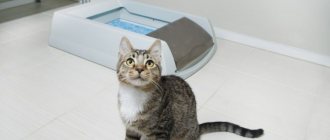Owners of cats may encounter an unusual condition of the animal: the cat is trembling as if it is cold. The owners see the reason that the pet is simply cold.
But the frequent repetition of this phenomenon serves as a signal that pathological processes are developing in the animal’s body, the animal is experiencing severe stress, and has become infected with an infectious disease.
Unreasonable trembling should be a reason to contact a veterinary clinic to a specialist, where the doctor will identify the presence of disorders and prescribe treatment.
The cat is shaking - the main reasons
Tremor (whole body trembling) is a rhythmic muscle contraction caused by internal or external factors, such as:
- change in temperature,
- reaction to stressful situations,
- sexual arousal,
- pathology.
- Cold, heat.
If the animal begins to tremble, having wet its skin, this behavior is normal. The furry predator is able to withstand low air temperatures, but does not tolerate humidity well.
The problem is especially urgent for a kitten; self-regulation of the body in babies is still weak, they are especially sensitive to humidity, but the development of seizures indicates a serious illness. Overheating of the body can lead to heatstroke, which in turn leads to tremors.
- Fear.
Attentive owners notice that the pet’s behavior when seeing unfamiliar people or things looks like this: the body begins to shake from small tremors. Fear of the unknown, especially fear, causes symptoms such as tremors of the limbs and involuntary urination.
- Emotional excitement.
Strong emotions (negative or positive) can cause involuntary muscle contractions. The cat is trembling not because of poor health, but from joy after a long separation from the owner, and so on.
- The period of sexual hunting.
An animal in heat often trembles when it sees an individual of the opposite sex. The hormonal surge that begins when looking at a potential partner leads to trembling. If trembling occurs in an animal after sterilization, you should have your pet checked by a veterinarian.
Be sure to read:
Discharge in a cat: what does it mean, causes, norm and pathology, what to do, how to treat
Symptoms of poisoning in cats
Depending on the amount and toxicity of the poison, the duration of its effect on the cat’s body, the symptoms of poisoning may not always be very pronounced.
Depending on what the cat was poisoned with, the degree of toxicity and the amount of toxic substance that entered the animal’s body, the first symptoms of poisoning may appear after 6-8 hours. When poisoned by potent toxins or poisonous plants, symptoms of poisoning in a cat appear a few minutes after entering the gastrointestinal tract.
Symptoms of poisoning in cats:
Nausea progressing to vomiting. Before vomiting begins, the cat becomes very nauseous, the cat behaves restlessly, randomly moving around the room from place to place, makes constant swallowing movements, and meows pitifully. After some time, the cat begins to cough, tilt and stretch its head forward, and breathe frequently and deeply. After all this, the cat begins to contract in the abdomen and throat, ending with vomiting (vomiting in cats).
Diarrhea. During the day, a healthy cat goes to the toilet 1-2 times. With diarrhea, the cat begins to defecate much more often, while the volume of liquid feces in the cat's litter box becomes smaller each time, the feces become from pasty to watery, the color of the feces varies from black to red (with bleeding in the gastrointestinal tract) - diarrhea in cats.
Severe drooling. When a cat is poisoned, owners often notice severe drooling (the cat is drooling).
Decreased appetite to the point of refusing to feed.
Increased thirst. As a result of poisoning, the cat experiences severe dehydration (loss of fluid as a result of vomiting and diarrhea) and the cat drinks a lot to replenish lost fluid.
A sharp decrease in body temperature; sometimes a poisoned cat may have a fever.
Inadequate reaction of the pupils to light or lack of reaction (the pupils are constantly dilated or constricted).
Weakness, apathy, unsteady gait and drowsiness of a poisoned cat.
Pain on palpation of the abdominal area.
Visible mucous membranes become pale and icteric.
Inappropriate reaction to external stimuli.
In case of severe poisoning, the cat experiences shortness of breath, an increased pulse rate, and cardiac arrhythmias (bradycardia, tachycardia, arrhythmia). Poisoning with chemicals and poisons leads to impaired coordination of movements, paralysis and paresis of the limbs, severe agitation, and muscle spasms of individual muscles appear.
As a result of poisoning, the cat can be aggressive or, on the contrary, depressed. They try to hide in a dark corner of the room and meow constantly.
When bitten by insects, a cat develops allergic reactions, dermatitis (dermatitis in cats).
When to contact a veterinarian
If your cat often trembles and there are additional signs of ill health (increased aggression, lethargy, frequent bowel movements, vomiting, constipation), you should immediately visit a veterinary clinic.
- Tremor can be one of the symptoms when affected by toxic substances. The poison in the cat’s body is absorbed gradually, slight trembling is replaced by convulsions.
- Minor trembling coupled with lethargy may indicate the development of an infection.
- Infection with worms is accompanied by constipation or diarrhea, perversion of taste, and chills.
- Shaking of the entire body and head may indicate internal injuries.
- A tick bite may also be accompanied by trembling.
- Chills, accompanied by coughing, sneezing, and discharge from the sinuses, indicate damage to the bronchi and pneumonia.
- Damage to the meninges as a result of the development of meningitis, tick-borne encephalitis, borreliosis, rabies, is often accompanied by severe trembling and convulsions.
Symptoms of poisoning in cats
The first signs of poisoning in cats, the intensity of their manifestation largely depends on what caused this condition, namely on the type, degree of toxicity, and the amount of toxic substance in the animal’s body. For example, if a cat is poisoned by low-quality feed or stale food. The first pathological manifestations may appear after six to eight hours.
If the poisoning of a cat is caused by chemicals, potent toxins, or poisonous plants, signs of poisoning may appear a few minutes or hours after the penetration of dangerous substances into the gastrointestinal tract of the pet.
Symptoms of poisoning in cats:
- nausea, severe debilitating vomiting;
- profuse diarrhea;
- weakness, depression, drowsiness;
- pain on palpation of the peritoneum;
- corneal clouding, blepharospasm, dilated pupils;
- foamy discharge from the mouth;
- sour eyes, nasal discharge;
- pallor, yellowness of mucous membranes;
- increase, sharp decrease in body temperature;
- loss of appetite, complete refusal of food;
- weight loss;
- increased thirst;
- inadequate response to external stimuli;
- profuse salivation.
In severe cases of poisoning, shortness of breath, heart rhythm disturbances (arrhythmia, bradycardia, tachycardia), and rapid pulse are noted. Poisoning with chemicals and poisons can cause severe muscle spasms, impaired coordination of movements, cause paresis, paralysis of the limbs, and severe agitation.
When poisoned, cats can show aggression or, conversely, look depressed. Animals try to hide in dark corners, lie down on their bellies on the cold floor, tiles, and constantly meow, attracting the attention of their owners.
If a cat has been poisoned by potent poisons, foam comes from the mouth, severe tonic muscle spasms, convulsions, and shallow rapid breathing are noted. Possible sudden increase in temperature, chills, fever. The feces acquire a greenish tint and a foul odor. Vomit and feces contain a large amount of mucus, fibrin flakes, and may contain blood clots, threads, and inclusions.
Insect bites can provoke allergic reactions and dermatitis of varying severity. They provoke the development of acute inflammatory processes in various structures of the dermis.
Endo-neurotoxins of bacteria in infectious, bacterial, and parasitic diseases contribute to the development of severe intoxication and cause functional disorders in the functioning of various organs and systems.
What to do if your cat is shaking
If an animal exhibits involuntary trembling, the owner should:
- analyze previous events,
- exclude external factors (hypothermia, overheating, fear, sexual overstimulation),
- contact a veterinarian to diagnose the disease and begin treatment in time.
Do you know what to do if your pet is shaking due to external reasons?
- In case of hypothermia, warm the animal, dry the skin, and massage the body.
- In case of overheating, cool the body with cool compresses and inject water into the oral cavity from a syringe without a needle.
- In case of stress, calm the pet down and protect it from objects that cause fear.
- During sexual hunting, you need to carefully monitor the pet’s condition and give medications that reduce attraction to the opposite sex.
Types of discharge in cats
How can a cat be poisoned? - plants indoors and outdoors
- medications (eg, acetaminophen, NSAIDs, antidepressants, methylphenidate). Eat both your tablets, left in an accessible place, and if you yourself give the animal any drugs prohibited for animals or an overdose/incorrect application, for example, when treating with parasite drops. Many people use drugs for dogs/people for cats, causing them to become poisoned. Remember, the medications you use should only be for cats or those prescribed by your veterinarian. And do not forget about dosages, strictly according to the weight of the animal or according to the doctor’s prescription.
— food poisoning (unsuitable food for cats, poor quality or spoiled). Strictly contraindicated - chocolate, caffeine, onions, garlic, fatty meats, purchased minced meat, citrus fruits, grapes/raisins, apricots, all types of mushrooms, persimmons, nuts, all products with spices, sausages, smoked meats, sweets, canned food for people and much more other. The diet must be balanced especially carefully if your cat is on a natural diet, because poisoning may not be acute, one-time, but will manifest itself over time as chronic pathologies. Try not to buy food in bulk; it can often be spoiled; manufacturers recommend keeping the packaging sealed.
- chemicals, disinfectants in the house, poorly washed floors or other parts of furniture with leftover products can also cause cat poisoning. In case of poisoning with detergents, there may be: Vomiting, diarrhea with blood, difficulty breathing in the animal, convulsions. It is necessary to immediately give a large amount of water and take the cat to the clinic.
- Lead contained in paint, linoleum and batteries - a cat can be poisoned if it eats it.
— Apartment renovation is not only a big stress for many cats, but also a cause of poisoning in animals, for example, when you glue wallpaper, paint and other substances may attract your cat to taste
What plants can poison a cat? Considering our case with fake grass Plants that are poisonous to cats, this is a whole epic. It is very important to limit the contact of cats' faces with some of the plants that owners love so much and unknowingly bring home
Lilies are very poisonous to cats, causing acute kidney failure, vomiting, and lethargy. Cycad palms - cause vomiting, constipation/diarrhea, mainly affecting the liver.
Azalea, laurel, and aloe can cause diarrhea. Begonia - burns mucous membranes.
Asparagus and geranium (the whole plant is poisonous to cats, but especially the leaves) – stomach upset
Other toxic plants - yew, autumn crocus, foxglove, lily of the valley, ivy, boxwood, cyclamen, cyperus, iris, narcissus, snowdrop, calla lilies, hyacinth, tulip, chrysanthemum, belladonna, adonis, aconite, acacia, henbane, geranium, wisteria, St. John's wort, jasmine, honeysuckle, tansy, hellebore, celandine, onion, tomato, elderberry, dandelion, physalis, ficus, rhubarb and violet.
Remember that cats do not always choose only what is beneficial for themselves and not all grass and plants that they can eat are harmless to them. It is important to grow flowers at home that are not dangerous to cats; gift bouquets should also be inaccessible to them.
What are the types of poisoning in cats in the summer, during the summer season? For example, if in the summer a cat is walking on its own in the countryside, when going outside, animals, including cats, are at risk of being poisoned by substances that can poison them - rats, cockroaches, chemicals that are sprinkled on roads.
Poisoning with rat poison can lead to various bleeding (a characteristic sign) and shortness of breath. The antidote, vitamin K1 konakion, is quite difficult to find in our pharmacies, and doctors in clinics may begin to use other hemostatic agents and then search for konakion.
Fertilizers on plots are also dangerous during the summer season. Lawn and garden products can be toxic to animals who ingest them when they wash themselves after walking or lying in a recently treated area.
Poisoning in cats living in an apartment - what must be hidden from the animal? It is important to keep all medications and chemicals out of the reach of animals. When they are poisoned, there can be either mild poisoning - vomiting, diarrhea, or fatal poisoning, due, for example, to acute renal failure.
The most common reason for visiting clinics is food poisoning, when they are fed either spoiled ready-made food or natural food unsuitable for animals.
Compared to poisoning with strong poisons, ingestion of inappropriate food is less likely to lead to acute life-threatening conditions, but causes chronic diseases. What does the liver, pancreas, and stomach most often react to? For any unfavorable signs, even mild ones, it is important to show your animal to a doctor and undergo the necessary tests, even if symptoms such as vomiting and diarrhea could be prevented on your own. A course of additional medications may be required.
Drug poisoning: what medications must be hidden from your cat? Paracetamol is contraindicated in cats; it can cause swelling of the face, cyanosis of the mucous membranes (cyanosis), shortness of breath, renal failure, gastritis/stomach ulcers. In dogs it can cause nausea, vomiting, lethargy, and pale mucous membranes, but may be asymptomatic.
Animals are also contraindicated in such painkillers - non-steroidal anti-inflammatory drugs such as ibuprofen and indomethacin - they are very toxic and can also cause poisoning aspirin, piroxicam, caroprofen, naproxen, phenylbutazone.
Their use with glucocorticoids is especially contraindicated. They can cause stomach ulcerations, stool and vomiting of blood (“coffee grounds”), abdominal pain, and acute renal failure. In case of poisoning with these drugs, it is necessary to induce vomiting, and in case of aspirin poisoning, the stomach can and should be washed out, even if 3 hours have already passed after poisoning, since aspirin can form conglomerates.
If your beloved cat, who until recently was affectionate, active, cheerful, but began to behave unusually, unnaturally, became lethargic, refuses food and favorite treats, this cannot but be alarming. Any changes in behavior, decreased physical activity, and the appearance of uncharacteristic clinical symptoms such as high fever, chills, vomiting, diarrhea may indicate functional disorders in the functioning of organs and systems, as well as the development of bacterial, viral, and parasitic infections.
Often, similar symptoms in animals are observed with food poisoning or severe intoxication of the body. Basic knowledge of symptoms is necessary in order to provide your beloved pet with the necessary assistance as quickly as possible before the arrival of a veterinary specialist.
Situations that do not cause concern
Tremor is not always the cause of the disease. There are a number of reasons when this phenomenon does not cause much concern.
Cold
The most common factor that causes trembling in an animal's body is cold. No one is immune from hypothermia - and cats are no exception. If she is cold, she can tremble in different ways: large (this can be seen with the naked eye) or small (it is easy to notice the trembling by placing your palm on the pet’s body).
Emotional excitement
The cause of your pet's periodic trembling can be certain emotional states. For example, severe fear, discomfort from the appearance of strangers in the house, aggression. The tremor in this case is explained by the tension engulfing the cat. The animal is like a stretched string that is about to snap, and this is why it begins to tremble.
Not only negative emotions can cause this condition. A cat experiencing bliss may also tremble periodically. Many owners notice that when they return from work in the evening and a bored cat rushes towards them, rubs against their legs and purrs contentedly, it literally shakes with joy. This is fine. You should not leave your pet alone for a long time if she is experiencing separation so hard
Sex hormones
A very common reason for a cat to tremble is hormonal storms. They shock the animal's body when it needs mating. During such periods, the male frantically marks everything around him, screams heart-rendingly, demanding a bride, and suffers from a tremor that covers his entire body - from the ears to the tip of the tail.
The same goes for cats. During estrus, they also often tremble. It is better not to allow the animal to suffer in such a way. If kittens are not in your plans, sterilize your pet or at least buy pills that reduce libido.
"Sleepy" tremor
Sometimes owners notice that the cat trembles when it lies with its eyes closed. The tremor in this case is not constant. Rather, we can talk about periodic shuddering of the body or its individual parts (for example, paws).
There's no need to worry. If there are no other symptoms, such trembling only indicates that the animal is as relaxed as possible and receives true pleasure from rest. True, sometimes a cat trembles from a nightmare in which, for example, a huge dog is chasing it, or a coveted sausage has been taken away. It's not scary. The animal will wake up and everything will be fine. In extreme cases, you can wake him up.
Trembling as a warning sign
There are many different pathologies in which a cat trembles. The most common:
In search of an answer to the question of why a cat trembles like an aspen leaf, you should analyze all the factors and take a closer look at the pet. Are there other symptoms and, if so, what are they? Is the animal’s emotional state stable? does it want to “walk”; trembling occurs when the pet is sleeping or awake; etc.
All this is of great importance. If time passes and the situation does not normalize or there are accompanying alarming signs, the cat should be shown to a specialist as soon as possible.
An attentive owner of a mustachioed, striped, and perhaps completely hairless meowing pet (we are talking about) will definitely notice the changes that are happening to his animal. But how to react to them? Should you always bother your veterinarian? Or perhaps the symptoms that frighten us are not some kind of terrible pathology?
Today we invite you to talk about why a cat or cat may tremble, what diseases such trembling can be a symptom of, and how to help an animal in this situation
Tremors in cats - causes of tremors in cats, diagnosis, treatment. Veterinary clinic "Zoostatus"
In some cases, kittens begin to tremble due to pathological processes occurring in the body. Among the most common are the following:
- Worms (or helminths). They pose a rather serious danger to the health and even life of the kitten, since they can completely clog the intestines. It is imperative to combat parasites.
- Spinal injury. It can happen during the birth of a kitten and at first it does not manifest itself in any way. Over time, pinched nerves inevitably make themselves felt. The pet shakes as if he is cold, his coordination of movements is impaired, and his limbs may completely fail.
- Vitamin B deficiency. It can be eliminated by adding brewer's yeast to the baby's diet.
- Lack of calcium. Quite common in kittens separated from their mother early. A sure sign of this problem is unsteady standing. The kitten is trying to stay afloat, maintain balance, tenses up a lot and trembles as a result. He needs to be given special calcium supplements.
- Kidney dysfunction. They are more common in adult cats, but can also occur in children. Requires mandatory veterinary assistance. It is necessary to take diuretics and anti-inflammatory drugs.
- Rhinotracheitis. A very serious pathology of a viral nature. Affects the musculoskeletal system. It can lead to disability and even death of the kitten. Accompanied by discharge from the genital tract and nasal passages, vomiting, fever with high fever. The kitten is not just trembling, he is literally shaking. Medical attention is required immediately.
These are the main reasons why a kitten may be shaking. If the baby feels generally fine, and there are no other alarming symptoms, and the tremor goes away as quickly as it started, there is no need to worry too much, but it is worth watching the animal.
In cases where additional signs are present, the kitten looks sick or tired, you need to show it to a specialist. Timely identification of the cause can save your pet's life.
Paws tremble most often when the cat’s body is infected with the herpes virus or when loryngotrocheitis develops. The main symptoms of such pathologies, in addition to the fact that the cat’s hind legs are trembling, are:
- nasal discharge;
- cough;
- temperature increase;
- lethargy.
Trembling in the paws may also occur due to advanced helminthiasis or cystitis. In such a situation, paw trembling is aimed at relieving discomfort in the abdominal cavity. Treatment for the appearance of pathological tremors should be carried out urgently. Postponing it for days, and moreover, for a month, is unacceptable, as this may pose a threat to the life of the pet. The help of a veterinarian will be necessary.
The reasons that lead to trembling in an animal are numerous.
These are both external factors (toxic substances) and internal diseases.
Trembling limbs
Trembling in the limbs of a pet can be caused by a herpes virus infection or rhinotracheitis of the animal. The main symptoms of this disease are purulent discharge from the nose and eyes, cough, vomiting, and fever.
Trembling of the limbs can be caused by worms or cystitis; by shaking the limbs, the cat tries to reduce itching or pain when helminths are active or the discomfort that arises during urination.
Head shaking
Quite a few reasons can lead to systematic or periodic twitching of an animal’s head. Frequent twitching may be a sign of otodectosis or ear scabies. In addition to twitching, you can observe how the animal often scratches the affected ear, literally plunging its paw into the ear canal and injuring the tissue. At the same time, the cat may meow pitifully.
Systematic head twitching can be a sign of otitis media, while the cat’s ear hurts and she won’t let it be touched. Or it may be evidence of the formation of sulfur plugs.
Head twitching may indicate liver failure, acute disruption of the respiratory system and even the kidneys. If the functioning of internal organs is disrupted, the disease occurs with a characteristic clinical picture of a particular disorder. Tremor appears already at the stage of organ failure.
Encephalitis, the use of certain medications, vestibulopathy, cerebellar pathologies, and traumatic brain injuries can cause tremors and even seizures.
Trembling croup and generalized tremor
Lesions of the spine (compression fractures, tumors, deformation of intervertebral discs, spinal stenosis) can lead to weakness of the lower extremities and trembling when the animal tries to stand on its feet. With further development of the disease, paralysis occurs.
Weakness as a result of illness or pain can lead to trembling of the animal's limbs or general trembling. For example, a swallowed sharp object, damaging the stomach or intestines, can cause the animal to meow pitifully, arch its back and tremble.
Neuromuscular diseases, degenerative neurological pathologies, myelin deficiency, metabolic pathologies and even poisoning by toxins (for example, organophosphates) can cause severe tremors throughout the animal's body.
Cat and Cat
Treatment
Physiological tremor in cats does not require medical intervention. To eliminate it, it is enough to minimize stress factors, provide the animal with comfortable living conditions and a nutritious, balanced diet.
If there are regular bouts of trembling, the animal must be shown to a veterinarian.
Important! You cannot independently relieve attacks of tremor in cats using sedatives or antispasmodics intended for humans. This can provoke complications or blur the clinical picture of the disease, which will significantly complicate the diagnosis.
Treatment of pathological tremor in cats consists of eliminating the cause of its occurrence. It can be expressed in the prescription of sedatives and anthelmintic drugs. In the presence of infectious processes, antimicrobial and symptomatic therapy is carried out. In the case of neoplasms or serious pathologies of the nervous or musculoskeletal system, surgical intervention is prescribed.
If the owner notices nervous twitching of the body in his cat, he needs to undergo a full course of examination at the clinic. This will help to identify the pathology in a timely manner and begin appropriate treatment. If the tremors are a consequence of poor nutrition or care, the veterinarian will point out the shortcomings and make adjustments that will help avoid the appearance of tremors in the future.











